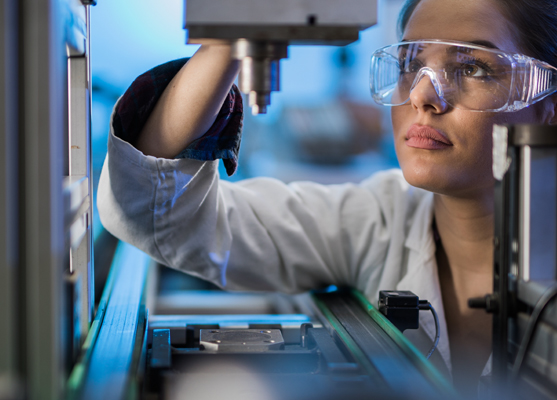International Women’s Day: Insights from four women in STEM
Across Australia, women are delivering ground-breaking research and innovation within science, technology, engineering, and mathematics (STEM).
In celebration of International Women’s Day, we spoke to four women involved in IMCRC’s manufacturing research projects about their careers, why gender equality matters and what we can do to inspire more girls to pursue STEM.
Dr Hannah King, Postdoctoral Research Fellow, Swinburne University of Technology
In school, Hannah King remembers feeling frustrated that home economics was compulsory.
“We had to learn how to cook and sew, but our school rarely scheduled hands-on science experiments, and there was no option to learn workshop or engineering skills,” she said.
“But I was lucky enough to have a passionate female science teacher who performed science demonstrations. I wanted to be like that – I wanted to love science and to make science real.”
Hannah now works as a postdoctoral research fellow for a research and development (R&D) team at Swinburne called Surface Engineering for Advanced Materials (SEAM). SEAM partnered with Lightning Protection International (LPI) to innovate one of their lighting strike protection devices.
“And eureka! We were able to develop something totally unique, and are now making full-scale prototypes for LPI,” she said.
Hannah credits this successful outcome to the diversity of her R&D team.
“R&D is all about innovating. Your team shouldn’t be comprised of 10 people who all think the same way. You need 10 people who have a diversity of knowledge and experience to come up with something that has never been done before,” she said.
“Gender equality isn’t about forcing the quota 50% men and 50% women. It’s about opening STEM up to new perspectives by providing opportunities for those atypically represented in STEM.”
Wendy Bourke, Senior Project Manager – Innovation, Research & Technology, Hunter Class Frigate Program, BAE Systems Australia
Wendy Bourke vividly remembers the moment she decided to pursue a career in engineering.
“I was 10 years old, and it just clicked,” she said.
But it doesn’t happen this way for everyone, and to inspire the next generation of women in STEM, Wendy believes we need to start discussions about career opportunities early on.
“We need to promote STEM using passionate and engaging storytelling that’s backed up by real-life experiences.
“By bringing STEM to life for our younger generations, we will be able to harness the diverse talent we need to solve the world’s greatest challenges.”
And within her career, Wendy has experienced first-hand the value in assembling a multi-talented and diverse team.
“I’m most proud of establishing a team who have brought very different aspects to the project and ensured success by constantly questioning the norm,” she said.
“Including individuals with diverse backgrounds enables a free-thinking, non-traditional approach to problem solving or solution design.”
Cristyn Davies, Research Fellow – Specialty of Child and Adolescent Health, Faculty of Medicine and Health, University of Sydney
Cristyn Davies is working with biotech company Vaxxas to develop an innovative intradermal patch that can deliver a vaccine without the use of a needle. For Cristyn, it’s engaging in clinical research with end-users of the patch that brings her the most joy.
“There’s something so rewarding about working with a diverse group of people during clinical research to ensure we achieve the best outcomes for public health and well-being,” she said.
Cristyn applied this outcomes-focused approach to building her team, and along with her colleagues, is committed to diversity and inclusion in the workplace.
“Our team includes a broad range of talented individuals, with women leading the collaboration,” she said.
“Diverse teams, not just in terms of skills mix but also gender, sexuality, ethnicity, ability, age, and other key demographic characteristics, are better placed to solve complex problems.
“And showcasing talented women and gender diverse people in the field, their varied career pathways, and the impact of their work is key to cultural change and inclusion and will also inspire future generations to pursue STEM.”
Lydia Gunawan, Project Research Officer, IMCRC
Lydia Gunawan recently joined IMCRC with an extensive background in research, having spent the past 10 years working on a preclinical study on therapeutic treatment for Parkinson’s and Alzheimer’s disease.
“I’ve always loved the human-centric nature of research. While science can be quite technical, it links back to making life better for people,” she said.
As Lydia recalls, she’s lucky to have been raised by parents who encouraged her to pursue a career in science.
“I was an inquisitive child and loved to learn. My parents supported my desire to undertake tertiary study and pursue a career in science. There’s no doubt in my mind that I would not be where I am today without their belief in me,” she said.
And while support is critical, Lydia also believes to inspire more girls to enter STEM, we need to change the narrative in the classroom.
“It’s important we show students that women can achieve great things in STEM.
“We know diversity brings innovation. With an absence of women in STEM, society is missing out on engaging some of our world’s brightest minds.”

